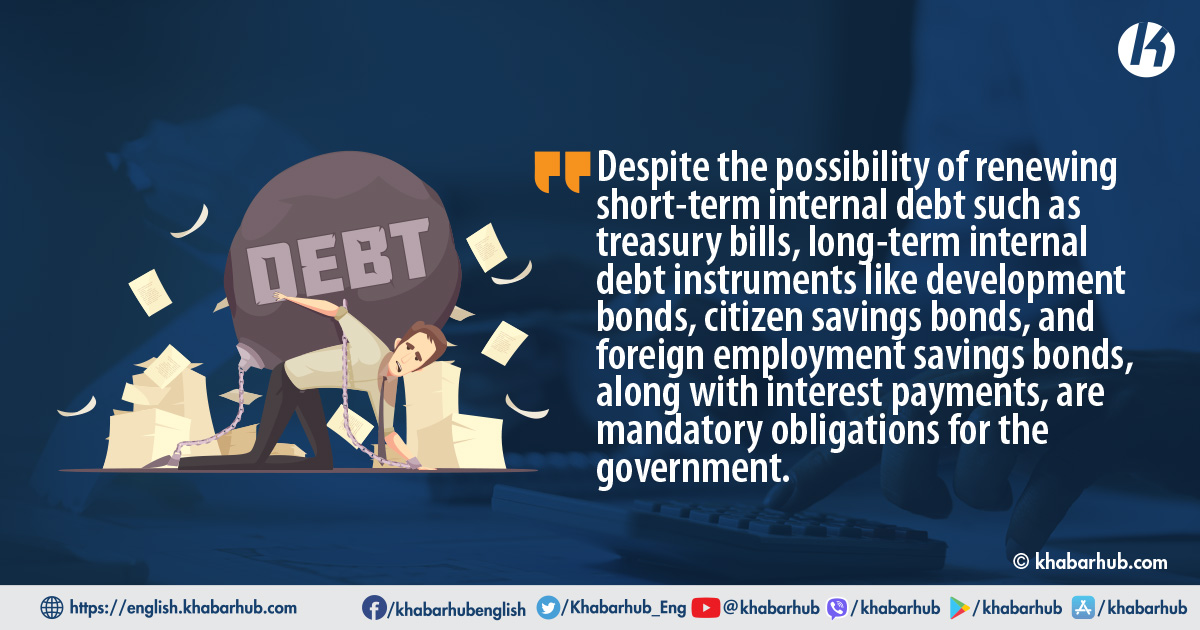KATHMANDU: The government finds itself in a critical situation, compelled to borrow money to pay off both the principal and interest of the public debt.
This is because Nepal’s economic stability is being seriously compromised by the escalating weight of internal debt.
As of the end of the financial year 2077/78, the country’s total internal debt stood at Rs 8 trillion 3 billion, but within the first quarter of the ongoing fiscal year, it surged to a staggering Rs 11 trillion 84 billion.
Consequently, over the past two years and three months, the burden of internal debt has swelled by Rs 3 trillion 80 billion 63 billion, representing an alarming increase of approximately 50 percent.
Internal bebt overtakes external debt
Traditionally overshadowed by external debt, Nepal’s internal debt has now surpassed it.
By mid-October in the current financial year, the external debt amounted to Rs 11 trillion 71 billion 233 million, while the internal debt surged to Rs 11 trillion 83 billion 57 billion 21 million.
According to data from the Public Debt Management Office, the country’s total internal debt stood at Rs 11 trillion 29 billion, with the external debt reaching Rs 11 trillion 70 billion by the conclusion of the last fiscal year.
Mounting Public Debt
The government’s public debt has skyrocketed to a staggering Rs 23 trillion 54 billion 59 billion 52 million as of mid-October.
This represents an increase of over Rs 50 billion in just three months, up from the Rs 22 trillion 99 billion 35 million recorded at mid-July.
During the current fiscal year, the government has accrued a total of Rs 1 trillion 6.78 billion rupees in public debt while paying off Rs 51.54 billion 53 million of the public debt.
Underscoring the government’s challenges
In the current fiscal year’s budget, the government had set a target to raise Rs 2 trillion 40 billion from internal debt and over Rs 2 trillion 12 billion from external debt.
As of mid-October in the current fiscal year, the government has mobilized Rs 97.31 billion from internal debt and Rs 9.478 billion from external debt.
While more than 40 percent of the government’s total annual target has already been mobilized, the actual mobilization of external debt remains significantly lower, at around 4.5 percent only.
In September-October alone, the government mobilized Rs 53.5 billion of internal debt and Rs 2.38 billion of external debt.
Similarly, in August, the government mobilized 31.2 billion rupees in domestic and Rs 4.37 billion in external loans.
In July, Rs 13.6 billion rupees of domestic and Rs 2.71 billion 83 lakh of external debt were mobilized.
Consequently, the government has aggressively increased public debt in the initial quarter of the current fiscal year.
While government revenue suffices to cover general expenses, it falls short of servicing the debt and interest payments on the public debt.
During the first quarter, the government mobilized over Rs 1 trillion rupees in public debt, both internally and externally, while expending Rs 67 billion 700 million 71 million on the principal and interest payments of public debt.
Of this, Rs 42.84 billion 17 lakh went towards internal debt payments, and Rs 8.70 billion 36 lakh towards external debt.
Additionally, Rs 13 billion 715 million were spent on internal debt interest payments, and Rs 2 billion 44 million on external debt interest payments.
After allocating approximately Rs 68 billion for the principal and interest payments of the public debt, the government had to resort to mobilizing internal debt to meet these obligations.
Moreover, the government’s capital expenditure reached Rs 26 billion 55 million as of October 13, accounting for 8.63 percent of the annual budget target.
Simultaneously, expenditure on financial arrangements amounted to Rs 51 billion 45 million 57 million, which represents 16.74 percent of the annual budget target.
Despite the possibility of renewing short-term internal debt such as treasury bills, long-term internal debt instruments like development bonds, citizen savings bonds, and foreign employment savings bonds, along with interest payments, are mandatory obligations for the government.
Moreover, the government, which must also honor foreign debt loan repayments and interest, has already mobilized approximately Rs 1 billion in domestic debt in the first quarter of the current financial year.









Comment